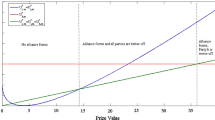Abstract
This paper considers the players' behaviour in an asymmetric two-player contest. When do they decide to “struggle” and when to “subjugate”? Analysing contest-success functions it is found that two crucial prerequisites for “struggle” or “war” have to be met. Thus, such an equilibrium is possible but restrictive. If a self-interested rule-setter chooses the contest-success function endogenously we show that one player will always subjugate. Applications to rent-seeking and environmental regulation are discussed.
Similar content being viewed by others
References
Appelbaum, E. and Katz, E. (1986). Transfer seeking and avoidance: On the full social costs of rent seeking. Public Choice 48: 175–181.
Baik, K.H. and Shogren, J.F. (1992). Strategic behavior in contests: Comment. American Economic Review 82: 359–362.
Dasgupta, P. and Stiglitz, J. (1980). Industrial structure and the nature of innovative activity. Economic Journal 90: 266–293.
Dasgupta, P. (1986). The theory of technological competition. In J.E. Stiglitz and G.F. Mathewson (Eds.), New developments in the analysis of market structure, 519–547. MIT Press, Cambridge, MA.
Dixit, A. (1987). Strategic behavior in contests. American Economic Review 77: 891–898.
Fudenberg, D. and Tirole, J. (1993). Game theory, 3rd print, MIT Press, Cambridge, MA.
Gialloretto, (1989). Selective regulation: A trend of the '90s. The Avmark Aviation Economist Dec. 1989: 15–17.
Hillman, A.L. and Riley, J.G. (1989). Politically contestable rents and transfers. Economics and Politics 1: 17–39.
Hillman, A.L. and Samet, D. (1987). Dissipation of contestable rents by a small number of contenders. Public Choice 54: 63–82.
Hirshleifer, J. (1989). Conflict and rent-seeking success functions: Ratio vs. difference models of relative success. Public Choice 63: 101–112.
Hirshleifer, J. and Riley, J.G. (1978). Elements of the theory of auctions and contests. UCLA working paper No. 118B.
Körber, A. and Kolmar, M. (1994). A comment on ‘conflict and rent-seeking success functions: Ratio vs. difference models of relative success’ by Jack Hirshleifer, Universität Konstanz, mimeo.
Leininger, W. (1993). Patent competition, rent dissipation and the persistence of monopoly: The role of research budgets. Journal of Economic Theory 53: 146–172.
Maloney, M.T. and McCormick, R.E. (1982). A positive theory of environmental quality regulation. Journal of Law and Economics 25: 99–124.
Nitzan, S. (1994). Modelling rent-seeking contests. European Journal of Political Economy 10: 41–60.
Oster, S. (1982). The strategic use of regulatory investment by industry sub-groups. Economic Inquiry 20: 604–618.
Salop, S.C. and Scheffman, D.T. (1983). Raising rivals' costs. American Economic Review 73 (Papers and Proceedings): 267–271.
Tullock, G. (1980). Efficient rent seeking. In J.M. Buchanan, R.D. Tollinson and Gordon Tullock (Eds.), Towards a theory of the rent seeking society. (College Station, Texas A & M Press).
Ursprung, H.W. (1990). Public goods, rent dissipation, and candidate competition. Economics and Politics 2: 115–132.
Author information
Authors and Affiliations
Rights and permissions
About this article
Cite this article
Körber, A., Kolmar, M. To fight or not to fight?. Public Choice 88, 381–392 (1996). https://doi.org/10.1007/BF00153239
Accepted:
Issue Date:
DOI: https://doi.org/10.1007/BF00153239



